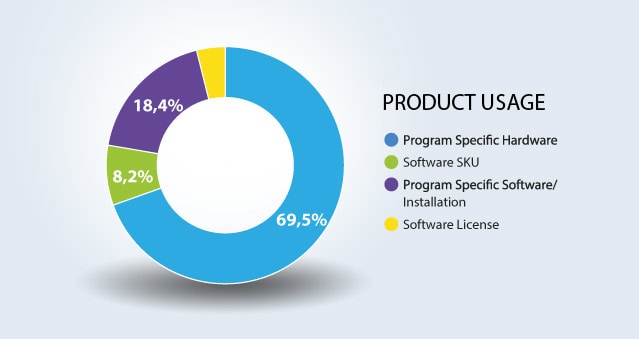The next evolution of pricing models is transforming how companies bill for products and services. Known as consumption-based pricing, this model charges customers based on their actual usage rather than a fixed fee. Also referred to as pay-as-you-go billing, usage-based, or metered billing, it follows a simple principle: “Use more, pay more; use less, pay less.”
Historically this was the pricing model of choice for utility companies like electric, gas, and water. However, companies within other industries are adopting consumption-based pricing in record numbers. Originally pioneered by infrastructure companies like Amazon Web Services (AWS) and Azure, this pricing model has gained in popularity among software providers such as software-as-a-service (SaaS) organizations, as well as IT services, cloud computing, and storage companies. In fact, in 2018 the adoption rate for usage-based pricing was 27%, nearly doubling to 46% in 2022 – with an additional 15% of companies actively testing this pricing model.
Consumption-based pricing allows organizations to track and bill for specific usage metrics, such as API calls, bandwidth, storage, or minutes used. While it offers flexibility for both businesses and customers, implementing this model involves careful planning – factoring in minimum usage commitments, account limitations, and hybrid pricing structures. As more industries embrace this model, companies must weigh its benefits against the operational complexities of billing and tracking consumption at scale.
Explication des modèles de tarification basés sur la consommation
Les modèles de tarification basés sur la consommation les plus courants sont les suivants
- Par unité ou paiement à l'utilisation : ce modèle de tarification permet aux clients de ne payer que ce qu'ils consomment.
- Tiered pricing: Customers determine which tier best suits their needs. Once the customer reaches or exceeds the tier allowance, they are automatically moved to the next tier. Typically, the starter tier is provided for free.
- Volume pricing: A price-per-unit pricing model that is based on the highest tier the customer reaches during the billing cycle.
- Tarification à l'unité : Également connue sous le nom de "paiement à l'utilisation", cette stratégie de tarification consiste à facturer les clients en fonction des ressources utilisées, comme les passerelles API qui facturent par appel API.
- Multi-attributs : Ce modèle de tarification facture les clients sur la base d'une combinaison de plusieurs paramètres.
Bien que la liste ne soit pas exhaustive, d'autres modèles de tarification basés sur la consommation comprennent l'abonnement + le paiement à l'utilisation, l'échelonnement avec dépassement, le paiement à la croissance et le paiement à l'épargne.
Avantages et inconvénients de la tarification à la consommation
Bien qu'elle ne soit pas aussi simple que d'autres modèles de tarification tels que la tarification forfaitaire, la tarification basée sur la consommation est avantageuse pour les entreprises comme pour les clients.
- La transparence de ce modèle permet à l'entreprise d'aligner facilement les coûts sur la consommation.
- Simplifie le processus d'alignement des revenus récurrents sur l'utilisation réelle, ce qui peut faciliter la budgétisation et les prévisions.
- Fournit l'agilité et la flexibilité nécessaires pour répondre rapidement à l'évolution de l'entreprise, des clients et des tendances du marché.
- Permet aux entreprises de se développer plus rapidement grâce à des prix attractifs pour une clientèle plus large.
- Élimine ou raccourcit les cycles d'achat.
- Améliore la fidélisation des clients en leur permettant de passer à un niveau supérieur ou inférieur en fonction de leurs besoins et de leur budget.
- Réduit les pertes de revenus, car vous êtes mieux à même d'optimiser l'utilisation des produits et des services.
- Il vous permet d'expérimenter et de tester rapidement différentes combinaisons de revenus récurrents et de prix basés sur la consommation.
- Permet de collecter des quantités massives de données, qui peuvent être utilisées pour déterminer comment les clients utilisent les produits et les services fournis.
- Offre un avantage concurrentiel en vous permettant de combiner des modèles de tarification basés sur la consommation avec des fonctionnalités ou des options supplémentaires pour créer des forfaits et des offres groupées différenciés.
- Augmentation de l'attrait pour les investisseurs - en moyenne, les entreprises qui intègrent un modèle de tarification basé sur la consommation se négocient à un multiple de revenus supérieur de 50 % à celui de leurs homologues.
From a customer perspective, they can more easily equate value to price. Additionally, a consumption-based pricing model empowers them to only take advantage of the features and options needed but gives them more control over their budgets.
Inconvénients pour les entreprises
Contrairement aux modèles de tarification par abonnement, la fluctuation de l'utilisation peut se traduire par un flux de revenus moins prévisible. Toutefois, cela ne doit pas nécessairement être négatif. Alors que les revenus mensuels peuvent augmenter et diminuer selon que l'entreprise conserve ses clients ou en acquiert de nouveaux, les revenus annuels devraient rester stables ou augmenter.
En outre, sans la bonne plateforme de facturation, la facturation peut devenir beaucoup plus compliquée car les frais de consommation sont généralement facturés à terme échu. Enfin, compte tenu des règles de comptabilisation des revenus de l'ASC 606 et de l'IFRS 15, le respect de ces réglementations lors du traitement manuel de la comptabilisation des revenus basés sur la consommation peut prendre beaucoup de temps et être source d'erreurs.
Les composantes d'un modèle de tarification basé sur la consommation
Étant donné que les modèles de tarification basés sur la consommation reposent sur des paramètres d'utilisation, il est essentiel de disposer des bonnes données. Voici les trois éléments nécessaires pour vous aider à suivre l'utilisation exacte.
Facturation au compteur
Le succès d'un modèle de tarification basé sur la consommation repose essentiellement sur votre capacité à suivre la quantité exacte d'utilisation. La facturation au compteur (ou facturation basée sur l'utilisation) incorpore une unité d'utilisation (par exemple, pour les compagnies d'électricité, il s'agit de watts et de kilowatts) et facture un montant fixe par unité utilisée.
Médiation
Comme toutes les données ne sont pas toujours présentées dans le même format, un moteur de médiation est nécessaire. Celui-ci vous permet de collecter et de convertir les données d'utilisation brutes provenant de sources multiples, de filtrer les enregistrements d'utilisation superflus et d'acheminer les informations à évaluer et à facturer.
Par exemple, dans le cas de la voix sur IP (VoIP), la médiation saisit et normalise des données telles que la durée de l'appel, le transfert de mégaoctets de données, la tarification de l'utilisation de la vidéo et le nombre de messages textuels provenant de services de messages courts (SMS) ou de services de messages multimédias (MMS).
Facturation
Lorsque les données ne passent pas par un moteur de médiation, la facturation mesure l'utilisation par intermittence tout au long de la période de facturation. À la fin du cycle de facturation, la facturation utilise les informations relatives à l'utilisation pour déterminer le prix, les plans, la manière de facturer et d'autres variables de tarification telles que les remises et les promotions.
Best Practices for Implementing Consumption-Based Pricing
Successfully adopting a usage-based pricing model requires careful planning and execution. By following structured steps and mitigating potential risks, businesses can build a scalable and transparent pricing strategy that enhances customer satisfaction and revenue growth.
Step-by-Step Implementation:
- Conduct Usage Pattern Analysis: Identify key customer usage patterns as well as customer needs and behaviors to determine the most effective pricing structure.
- Pilot with Select Customers: Test the model with a small customer group to refine consumption pricing strategies and address any unforeseen challenges.
- Develop Transparent Pricing Structures: Clearly communicate how charges are calculated to build trust and prevent billing confusion.
Risk Mitigation Strategies:
- Leverage Advanced Billing Platforms: Automate data collection, metering, and invoicing to reduce errors and maintain compliance with financial regulations.
- Train Sales Teams: Equip teams to manage hybrid pricing models and flexible pricing models while handling customer inquiries effectively.
By implementing these best practices, companies can seamlessly transition to a consumption-based usage pricing model while maintaining customer confidence and revenue predictability.
Industry Use Cases and Adoption Challenges
As consumption-based pricing gains traction, industries across the board are integrating this model to enhance customer flexibility and optimize revenue. However, adoption comes with unique challenges, particularly in balancing revenue predictability, accurate billing, and technological investment.
Key Industries Adopting Consumption-Based Pricing
- SaaS (Software as a Service): Many SaaS companies are embracing usage-based pricing to align costs with customer value. However, integrating hybrid pricing models – which blend subscriptions with metered usage – can be complex, requiring precise revenue management and forecasting.
- IT Services & Cloud Computing: Providers like Amazon Web Services (AWS) and Microsoft Azure rely on consumption-based models, billing customers for resources such as bandwidth, storage, and processing power. A major challenge in this space is accurate data tracking and transparent invoicing to maintain customer trust.
- Utilities & Energy Providers: Long familiar with metered billing, utility companies face the challenge of standardizing pricing models across diverse infrastructures. Factors like seasonal demand fluctuations and regulatory compliance further complicate billing accuracy.
Adoption Challenges and Considerations
- Revenue Predictability: Usage-based pricing can create fluctuations in monthly revenue, making financial planning more complex. Businesses must develop strong forecasting strategies to mitigate unpredictability.
- Billing Accuracy & Transparency: Customers demand clarity in their usage-based charges and real-time data tracking and automated invoicing are critical to maintaining
- Technology Investment: Implementing a scalable billing infrastructure is essential to handling complex customer usage and consumption data. Companies must invest in automated billing platforms that support dynamic pricing models and real-time analytics.
While consumption-based pricing presents clear advantages, businesses must carefully navigate these challenges to maximize the benefits of this evolving model.
Comment déterminer si la tarification à la consommation convient à votre entreprise ?
Deciding whether adopting a consumption-based pricing model is right for your business may be as simple as looking at your industry, products, services, and competition. While this pricing strategy isn’t right for every business, here are some questions that can help you determine if you should consider usage-based pricing.
- Pouvez-vous facilement et précisément ventiler l'utilisation en unités ?
- Les clients peuvent-ils facilement prévoir, avec un certain degré de précision, leurs besoins en matière d'utilisation ?
- L'utilisation et la valeur de vos produits et services augmentent-elles ?
If you answered yes to even one of these questions, it may be time to take a closer look at how you can incorporate consumption-based pricing into your pricing schemes.
Additional Considerations for Adopting This Model
Beyond basic fit questions, businesses may also consider evaluating external market trends and internal capabilities before making the switch. Consider the following factors to determine readiness:
- Industry & Competitor Landscape
- Are competitors already offering usage-based pricing? If so, adopting a similar model could improve competitiveness.
- Is there growing demand for more flexible pricing in your industry?
- Operational Readiness
- Does your product or service allow for scalable tracking and billing?
- Can you accurately monitor and communicate usage data to customers?
- Do you have the right billing infrastructure to handle real-time metering and invoicing?
- Customer Expectations & Business Alignment
- Have customers expressed interest in flexible, usage-based pricing?
- Does your company have the automation and analytics in place to support seamless billing and usage tracking?
By evaluating these factors, businesses can make informed decisions about whether consumption-based pricing aligns with their capabilities, market position, and long-term growth strategy.
Addressing Misconceptions About Consumption-Based Pricing
Despite its increasing adoption, consumption-based pricing is often misunderstood. Businesses considering a usage-based model should separate fact from fiction to make an informed decision.
Common Misconceptions & Counterpoints:
- “Consumption-based pricing always results in unpredictable revenue.”
- Reality: Advanced billing platforms help stabilize revenue streams by forecasting usage trends and managing customer commitments.
- “This model is too complex for small businesses.”
- Reality: Scalable billing solutions and automation make it accessible for businesses of all sizes, enabling easy implementation and management.
By leveraging the right technology, usage tracking tools, and strategic data-driven pricing structures, businesses can confidently adopt a consumption model while maintaining financial stability and customer trust.
Débloquer la croissance grâce à la tarification basée sur la consommation
While consumption-based pricing provides numerous benefits, as well as some potential pitfalls, when done well it can be a powerful tool to increase sales, drive operational efficiency, and improve customer loyalty. Key to your success is a powerful billing solution – one that delivers automatic rating, data mediation, and invoicing.
Unlike other cloud and legacy billing solutions, BillingPlatform aggregates and analyzes usage data from any source and transforms it into revenue potential – in real-time. Our solution enables enterprises to support any business model with any combination of one-time charges, subscription, consumption, or hybrid-based billing – all on a single platform.
We provide what’s important for consumption-based pricing success – usage, tiered, subscription, overages, minimum commitment, etc. – to enable you to dynamically manage pricing and unlock your company’s full growth and revenue potential.
Talk to our experts today if you’re ready to learn more!



